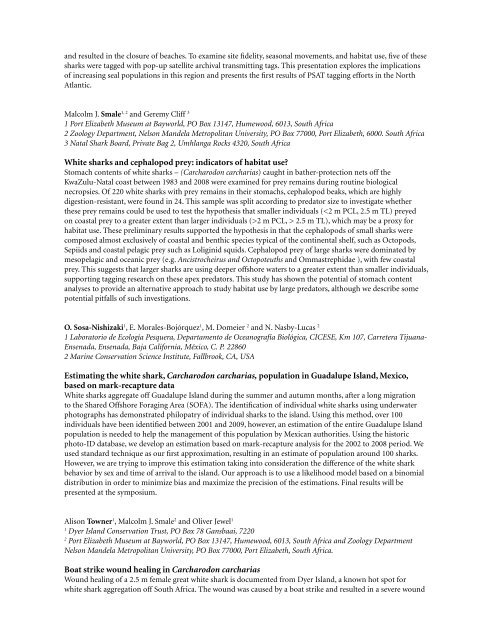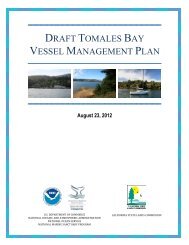Symposium program - Gulf of the Farallones National Marine ...
Symposium program - Gulf of the Farallones National Marine ...
Symposium program - Gulf of the Farallones National Marine ...
Create successful ePaper yourself
Turn your PDF publications into a flip-book with our unique Google optimized e-Paper software.
and resulted in <strong>the</strong> closure <strong>of</strong> beaches. To examine site fidelity, seasonal movements, and habitat use, five <strong>of</strong> <strong>the</strong>se<br />
sharks were tagged with pop-up satellite archival transmitting tags. This presentation explores <strong>the</strong> implications<br />
<strong>of</strong> increasing seal populations in this region and presents <strong>the</strong> first results <strong>of</strong> PSAT tagging efforts in <strong>the</strong> North<br />
Atlantic.<br />
Malcolm J. Smale 1, 2 and Geremy Cliff 3<br />
1 Port Elizabeth Museum at Bayworld, PO Box 13147, Humewood, 6013, South Africa<br />
2 Zoology Department, Nelson Mandela Metropolitan University, PO Box 77000, Port Elizabeth, 6000. South Africa<br />
3 Natal Shark Board, Private Bag 2, Umhlanga Rocks 4320, South Africa<br />
White sharks and cephalopod prey: indicators <strong>of</strong> habitat use<br />
Stomach contents <strong>of</strong> white sharks – (Carcharodon carcharias) caught in ba<strong>the</strong>r-protection nets <strong>of</strong>f <strong>the</strong><br />
KwaZulu-Natal coast between 1983 and 2008 were examined for prey remains during routine biological<br />
necropsies. Of 220 white sharks with prey remains in <strong>the</strong>ir stomachs, cephalopod beaks, which are highly<br />
digestion-resistant, were found in 24. This sample was split according to predator size to investigate whe<strong>the</strong>r<br />
<strong>the</strong>se prey remains could be used to test <strong>the</strong> hypo<strong>the</strong>sis that smaller individuals (2 m PCL, > 2.5 m TL), which may be a proxy for<br />
habitat use. These preliminary results supported <strong>the</strong> hypo<strong>the</strong>sis in that <strong>the</strong> cephalopods <strong>of</strong> small sharks were<br />
composed almost exclusively <strong>of</strong> coastal and benthic species typical <strong>of</strong> <strong>the</strong> continental shelf, such as Octopods,<br />
Sepiids and coastal pelagic prey such as Loliginid squids. Cephalopod prey <strong>of</strong> large sharks were dominated by<br />
mesopelagic and oceanic prey (e.g. Ancistrocheirus and Octopoteuths and Ommastrephidae ), with few coastal<br />
prey. This suggests that larger sharks are using deeper <strong>of</strong>fshore waters to a greater extent than smaller individuals,<br />
supporting tagging research on <strong>the</strong>se apex predators. This study has shown <strong>the</strong> potential <strong>of</strong> stomach content<br />
analyses to provide an alternative approach to study habitat use by large predators, although we describe some<br />
potential pitfalls <strong>of</strong> such investigations.<br />
O. Sosa-Nishizaki 1 , E. Morales-Bojórquez 1 , M. Domeier 2 and N. Nasby-Lucas 2<br />
1 Laboratorio de Ecología Pesquera, Departamento de Oceanografía Biológica, CICESE, Km 107, Carretera Tijuana-<br />
Ensenada, Ensenada, Baja California, México, C. P. 22860<br />
2 <strong>Marine</strong> Conservation Science Institute, Fallbrook, CA, USA<br />
Estimating <strong>the</strong> white shark, Carcharodon carcharias, population in Guadalupe Island, Mexico,<br />
based on mark-recapture data<br />
White sharks aggregate <strong>of</strong>f Guadalupe Island during <strong>the</strong> summer and autumn months, after a long migration<br />
to <strong>the</strong> Shared Offshore Foraging Area (SOFA). The identification <strong>of</strong> individual white sharks using underwater<br />
photographs has demonstrated philopatry <strong>of</strong> individual sharks to <strong>the</strong> island. Using this method, over 100<br />
individuals have been identified between 2001 and 2009, however, an estimation <strong>of</strong> <strong>the</strong> entire Guadalupe Island<br />
population is needed to help <strong>the</strong> management <strong>of</strong> this population by Mexican authorities. Using <strong>the</strong> historic<br />
photo-ID database, we develop an estimation based on mark-recapture analysis for <strong>the</strong> 2002 to 2008 period. We<br />
used standard technique as our first approximation, resulting in an estimate <strong>of</strong> population around 100 sharks.<br />
However, we are trying to improve this estimation taking into consideration <strong>the</strong> difference <strong>of</strong> <strong>the</strong> white shark<br />
behavior by sex and time <strong>of</strong> arrival to <strong>the</strong> island. Our approach is to use a likelihood model based on a binomial<br />
distribution in order to minimize bias and maximize <strong>the</strong> precision <strong>of</strong> <strong>the</strong> estimations. Final results will be<br />
presented at <strong>the</strong> symposium.<br />
Alison Towner 1 , Malcolm J. Smale 2 and Oliver Jewel 1<br />
1<br />
Dyer Island Conservation Trust, PO Box 78 Gansbaai, 7220<br />
2<br />
Port Elizabeth Museum at Bayworld, PO Box 13147, Humewood, 6013, South Africa and Zoology Department<br />
Nelson Mandela Metropolitan University, PO Box 77000, Port Elizabeth, South Africa.<br />
Boat strike wound healing in Carcharodon carcharias<br />
Wound healing <strong>of</strong> a 2.5 m female great white shark is documented from Dyer Island, a known hot spot for<br />
white shark aggregation <strong>of</strong>f South Africa. The wound was caused by a boat strike and resulted in a severe wound







